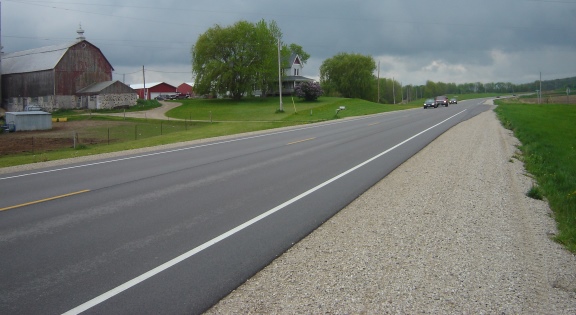As legislators debate how to trim the massive transportation portion of the next state budget, a federal judge has delayed a $166 million highway expansion project in eastern Wisconsin amid questions about the traffic forecasting methods that helped justify it.
In a late May ruling, U.S. District Judge Lynn Adelman sided with plaintiffs and blocked federal money for the expansion of Highway 23 to four lanes between Fond du Lac and Plymouth, telling the state Department of Transportation that its failure to fully explain how it arrived at its traffic projections and its decision not to consider updated population forecasts for those projections were “significant deficiencies.”

The nonprofit 1000 Friends of Wisconsin had challenged the project by filing a claim in the U.S. District Court in Milwaukee against the state DOT, Federal Highway Administration and others.
The case spotlights one of the key components of determining the scale of highway projects, which total billions of dollars in Wisconsin each year. Gov. Scott Walker’s state budget proposal calls for borrowing $1.3 billion to build highways over the next two years; the Legislature is trying to whittle that down to $800 million.
Critics such as 1000 Friends of Wisconsin — a Madison-based organization dedicated to sound land-use planning — seize on traffic projections, which are rarely accurate, in calling for less spending on highway projects. Wisconsin transportation officials are among the few in the country who study how to improve the accuracy of their projections.
“This is a tough business,” said David Hartgen, a former policy analyst for the Federal Highway Administration and an emeritus professor of transportation studies at the University of North Carolina at Charlotte. “It’s a very difficult area of forecasting. It’s been known to be for quite some time. There’s some movement now to improve it.”
Hartgen said most projections are off by around 25 percent.
“All these methods are pretty speculative,” he said. “They rely on assumptions that basically can’t be verified because they are future assertions, and some can be pretty optimistic. I’ve never run into a town that didn’t think it wouldn’t grow if a four-lane road was built connecting it.”
Hartgen saw an important similarity between the Highway 23 case and a ruling last week by a U.S. District Court judge in Chicago who said the Federal Highway Administration’s approval of a proposed expressway linking northern Illinois and Indiana was invalid.
“The Illiana Expressway case seems to be based on another argument; that the land-use forecast was the same no matter if the expressway (was or wasn’t built),” he said. “The Wisconsin case does not address that issue … But it seems from the discussion that the Wisconsin forecasts also have this fault. I wonder if the DOT folks or their consultants are aware of (that) decision.”
Federal funding for the Highway 23 project is blocked until the state Department of Justice attorneys representing the state DOT provide additional information on the traffic projections and population forecasts that satisfy Adelman, said DOT spokeswoman Peg Schmitt. A status conference has been scheduled for Sept. 3, she added.
That could be a tough case to prove, Hartgen said, as traffic forecasting models can be extremely complex and difficult to explain.
Wisconsin also will have to explain why its traffic projections didn’t incorporate new population forecasts that showed two-thirds less growth than the forecasts that were used.
Hartgen, who heads a consulting company that specializes in transportation planning, co-authored a report grading the states’ highway systems that ranked Wisconsin 16th for its overall highway performance in 2014. It’s important to take the long view in evaluating traffic projections, he said.
“It’s not so much the accuracy of a given time but rather, ‘How long will the capacity last before the growth catches up to it again?’ It’s a prediction of service life (of a highway) rather than accuracy at a given time,” he said.
Critics say an overly optimistic projection can mean the difference between approval of a highway expansion project from two to four lanes instead of a much cheaper maintenance alternative with passing lanes.
“The difference in costs is not insignificant,” said Steve Hiniker, executive director of 1000 Friends of Wisconsin.
A 2013 study by Hiniker’s group compared state traffic forecasts for 11 recent highway expansion projects to actual traffic counts gleaned from the DOT’s website. None were likely to meet the DOT’s projections, the study concluded.
Hiniker said the DOT’s $850 million proposal to expand the Interstate 94 corridor in Milwaukee between the Zoo and Marquette interchanges needs a longer look because the DOT is projecting a 24 percent increase in traffic there by 2040. The $1 billion Interstate 39-90 project between the Illinois state line and Madison should not be started until projections there are looked at more closely, he said.
“Does it need improvements? Yes. Does it need an additional lane? Probably not,” Hiniker said.
As legislators argue over what to do with the transportation budget, Hiniker said the state shouldn’t fund any new projects: “The position of 1000 Friends is to fund and finish what projects we’ve started and then develop a better transportation policy for the whole state.”
Officials from the state DOT, as well as those from Minnesota and Ohio, have written reports looking at finding better ways to accurately forecast traffic, especially in urban areas, Hartgen said. “Wisconsin should be credited here,” he added. “It’s one of only less than a handful of states looking at the question of forecast and where the sources of error are.”
Hartgen said many factors can throw off the accuracy of traffic forecasts: “Is the travel time the same? Is the price of gasoline the same? Are there alternative methods of travel?”
So far, there has been no thorough assessment of traffic model accuracy in the U.S., Hartgen said.
“England has done a much better job than we have. The British government has a initiative to track all road projects to see how well they’ve done. We haven’t even started that yet in the U.S.”
